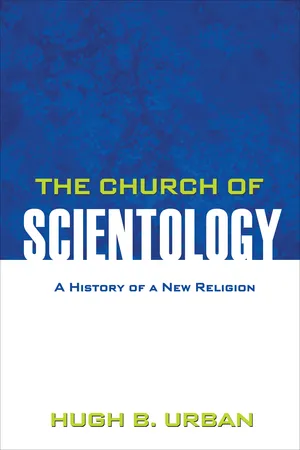![]()
- NOTES -
Introduction: The World's Most Controversial New Religion and
Why No One Writes About It
1. L. Ron Hubbard, “The Hope of Man,” June 1955, TBDS, vol. 2, 215.
2. Richard Behar, “The Scientologists and Me,” Time, May 6, 1991, 57.
3. “L. Ron Hubbard: The Founder of Scientology,” Aboutlronhubbard.org, 2006, http://www.aboutlronhubbard.org/eng/wis3_1.htm.
4. Federal Bureau of Investigation, airgram, April 17, 1951, Freedom of Information / Privacy Acts Section, Subject: Church of Scientology / L. Ron Hubbard, No. 62-94080. Hereafter cited as FBI.
5. “Mrs. Hubbard Torture Claim,” Los Angeles Examiner, April 24, 1951, 1.
6. Richard Behar, “Scientology: The Thriving Cult of Greed and Power,” Time, May 6, 1991, 50-57.
7. Joe Childs and Thomas C. Tobin, “Scientology: The Truth Rundown,” St. Petersburg Times, June 21, 2009, http://www.tampabay.com/specials/2009/reports/project/. The allegations made by the Times article have been repeated by many other sources, such as Laurie Goodstein, “Defectors Say Church of Scientology Hides Abuse,” New York Times, March 6, 2010, http://www.nytimes.com/2010/03/07/us/07scientology.html; and “Scientology: A History of Violence,” AC3600 (blog), CNN, March 25, 2010, http://ac360.blogs.cnn.com/2010/03/25/scientology-a-history-of-violence/.
8. See Church of Scientology of California, Press View the FBI Raid (Los Angeles: Church of Scientology of California, 1977), 1; Robert Gillette and Robert Rawitch, “Church Claims U.S. Campaign of Harassment,” Los Angeles Times, August 29, 1978, A1.
9. “David Miscavige: The Peacemaker,” Freedom, 2010, http://www.freedommag.org/david_miscavige_peacemaker.
10. Roy Wallis, The Road to Total Freedom: A Sociological Analysis of Scientology (New York: Columbia University Press, 1976); J. Gordon Melton, The Church of Scientology (Salt Lake City, UT: Signature Books, 2000); James R. Lewis, ed., Scientology (New York: Oxford University Press, 2009). See Harriet Whitehead, Renunciation and Reformulation: A Study of Conversion in an American Sect (Ithaca, NY: Cornell University Press, 1987); Hugh B. Urban, “Fair Game: Secrecy, Security and the Church of Scientology in Cold War America,” Journal of the American Academy of Religion 4, no. 2 (2006): 356-89. Several good articles by Stephen Kent are “The Creation of ‘Religious' Scientology,” Religious Studies and Theology 18, no. 2 (1999): 97-126; and “Scientology's Relationship with Eastern Religious Traditions,” Journal of Contemporary Religion 11, no. 1 (1996): 21-36.
11. See, among others, Dorthe Refslund Christensen, Scientology: Fra terapi tel religion (Copenhagen: Gyldendal, 1997); Friedrich-Wilhelm Haack, Scientology: Magie des 20. Jahrhunderts (Munchen: Claudius Verlag, 1991); Oliver Huber, Scientology: zwischen Verheimlichung und Desinformation (Hamburg: Institut fur Soziologie, 1994).
12. Urban, “Fair Game”; Urban, “The Rundown Truth: Scientology Changes Strategy in War with Media,” Religion Dispatches, March 17, 2010, http://www.religiondispatches.org/archive/atheologies/2358/the_rundown_truth%3A_scientology_changes_strategy_in_war_with_media_. Many scholars and journalists have recounted being harassed by the church. Among others, see Roy Wallis, “The Moral Career of a Research Project,” in Doing Sociological Research, ed. Colin Bell and Howard Newby (London: Allen and Unwin, 1976); Behar, “Scientology.”
13. Among the popular, nonacademic exposes available, two of the better ones are Jon Atack, A Piece of Blue Sky: Scientology, Dianetics and L. Ron Hubbard Exposed (New York: Carol, 1990); and Nancy Many, My Billion Year Contract (Bloomington, IN: Xlibris, 2009). Among the better journalistic accounts are Janet Reitman, “Inside Scientology,” Rolling Stone, February 23, 2006, http://www.rollingstone.com/politics/story/9363363/inside_scientology; and Lawrence Wright, “The Apostate: Paul Haggis vs. The Church of Scientology,” New Yorker, February 14, 2011, http://www.newyorker.com/reporting/2011/02/14/110214fa_fact_wright?currentPage=all.
14. Here I use the phrase “historian of religions” primarily in the more critical sense outlined by Bruce Lincoln, “Theses on Method,” Method and Theory in the Study of Religion 8, no. 3 (1996): 225-27. As Lincoln suggests, the task of the historian of religions is to analyze the temporal, material, social, and political aspects of those phenomena that are claimed to be transcendent and eternal: “To practice history of religions…is to insist on discussing the temporal, contextual, situated, interested, human, and material dimensions of those discourses, practices, and institutions that characteristically represent themselves as eternal, transcendent, spiritual, and divine.” In this sense, my approach here is similar to historians of religions such as Steven Wasserstrom, Religion after Religion: Gershom Scholem, Mircea Eliade, and Henry Corbin at Eranos (Princeton, NJ: Princeton University Press, 1999); Tomoko Masuzawa, The Invention of World Religions: Or How European Universalism was Preserved in the Language of Difference (Chicago: University of Chicago Press, 2005); Russell McCutcheon, Manufacturing Religion: The Discourse on Sui Generis Religion and the Politics of Nostalgia (New York: Oxford University Press, 1997); Ivan Strenski, Why Politics Can't Be Freed from Religion (Malden, MA: Wiley-Blackwell, 2010).
15. See chapter 2 below. See also L. Ron Hubbard, Technique 88: Incidents on the Track Before Earth (Los Angeles: Golden Era Productions, 2007), 185, 186, 183; Hubbard, Hubbard Professional Course Lectures (Los Angeles: Golden Era Productions, 2007), 110.
16. See chapter 5 below. See also Douglas Frantz, “Scientology's Puzzling Journey from Tax Rebel to Tax Exempt,” New York Times, March 9, 1997, http://www.nytimes.com/1997/03/09/us/scientology-s-puzzling-journey-from-tax-rebel-to-tax-exempt.html?pagewanted=all.
17. Jonathan Z. Smith, Imagining Religion: From Babylon to Jonestown (Chicago: University of Chicago Press, 1982), xi.
18. McCutcheon, Manufacturing Religion, 3.
19. David Chidester, “The Church of Baseball, the Fetish of Coca-Cola, and the Potlatch of Rock ‘n' Roll: Theoretical Models for the Study of Religion in American Popular Culture,” Journal of the American Academy of Religion 64, no. 4 (1996): 745.
20. Talal Asad, Genealogies of Religion: Discipline and Reasons of Power in Christianity and Islam (Baltimore, MD: Johns Hopkins University Press, 1993).
21. See Michael Barkun, “Religion and Secrecy after September 11,” Journal of the American Academy of Religion 74, no. 2 (2005): 275-301; Hugh B. Urban, “Secrecy and New Religious Movements: Concealment, Surveillance and Privacy in a New Age of Information,” Religion Compass 2, no. 1 (2007): 66-83.
22. Urban, “Secrecy and New Religious Movements”; Urban, “The Torment of Secrecy: Ethical and Epistemological Problems in the Study of Esoteric Traditions,” History of Religions 37, no. 3 (1998): 209-48.
23. And...
